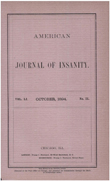Anorexia nervosa and bulimia nervosa in alcohol-dependent men and women and their relatives
Abstract
OBJECTIVE: Many of the studies linking anorexia nervosa and bulimia nervosa to substance use disorders suffer from problems with small samples; some lack rigorous definitions of the syndromes, and it is difficult to determine whether eating problems were primarily temporary consequences of heavy substance use or drugs were temporarily used in an effort to control appetite. The goal of this study was to evaluate the relationship between alcohol dependence and eating disorders. METHOD: Structured interviews were carried out with 2,283 women and 1,982 men as part of the Collaborative Study on the Genetics of Alcoholism. Data on drug abuse and dependence, psychiatric disorders, and symptoms of anorexia and bulimia were evaluated among alcohol- dependent probands, their relatives, comparison probands, and their relatives. RESULTS: Lifetime rates for anorexia and bulimia were 1.41% and 6.17%, respectively, for the alcohol-dependent women, and bulimia was observed in 1.35% of the alcoholic men. However, once the impact of additional primary diagnoses was controlled for, anorexia was seen in only 1.26% of the women with primary alcohol dependence and none of the alcohol-dependent men; the rates for bulimia were 3.46% and 0.72%, respectively. There was no evidence of a strong familial crossover between alcohol dependence and anorexia or bulimia. CONCLUSIONS: While the rate of anorexia was not elevated in alcoholics after controlling for other disorders, bulimia did occur at a greater than expected rate. However, both eating disorders were relatively rare, and much of the association with alcoholism occurred in the context of additional preexisting or secondary psychiatric disorders.
Access content
To read the fulltext, please use one of the options below to sign in or purchase access.- Personal login
- Institutional Login
- Sign in via OpenAthens
- Register for access
-
Please login/register if you wish to pair your device and check access availability.
Not a subscriber?
PsychiatryOnline subscription options offer access to the DSM-5 library, books, journals, CME, and patient resources. This all-in-one virtual library provides psychiatrists and mental health professionals with key resources for diagnosis, treatment, research, and professional development.
Need more help? PsychiatryOnline Customer Service may be reached by emailing [email protected] or by calling 800-368-5777 (in the U.S.) or 703-907-7322 (outside the U.S.).



